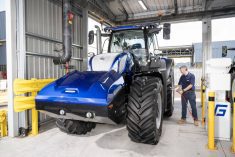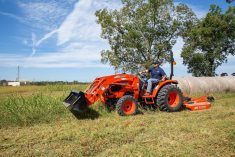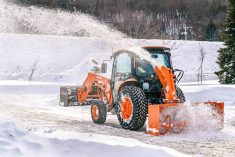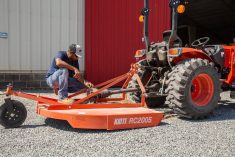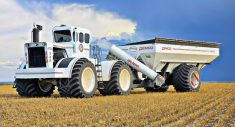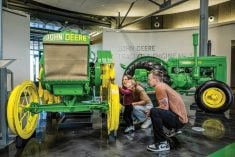In early January at the Consumer Electronics Show in Las Vegas, Nev., John Deere held what may arguably be a milestone press conference. The green brand announced it was set to launch commercial sales of a fully autonomous 8R tractor designed to work alone in tillage applications when mated with Deere’s Tru-Set chisel plow.
In his opening remarks, Jahmy Hindman, chief technology officer said, “The future of agriculture starts now.”
- VIDEO: Self-driving Deere looks to gain traction with farmers
Read Also

Claas brings 1000 Series SP forage harvesters to Canada
In mid-August, Claas unveiled its new line of Jaguar forage harvesters at an event in Visalia, California, deep in the heart of that state’s dairy region.
He may not have been exaggerating. This is likely to be the leading edge of a cascade of autonomous machines to hit the market soon from multiple brands, and that will eventually change farming in a profound way.
Deere even modified its traditional tagline, “Nothing runs like a Deere,” adding the word “autonomously” at the end as it appeared on stage behind presenters during the press conference.
In an earlier press conference last August, Deere’s Dan Leibfried, director of automation and autonomy, announced the company had purchased a California-based, tech startup firm called Bear Flag Robotics. That company had built a system to make Deere tractors fully autonomous in tillage work and was selling the system — on a regional scale — to farmers in that state. Leibfried said then Deere had plans to bring that autonomous system to market through its own dealers sooner rather than later.
The January announcement appears to be the implementation of that promise.
“I still get goosebumps every time I see that video (which was shown before she took the stage at the press conference) and think about how we’re going to revolutionize agriculture through autonomy,” said Deanna Kovar, vice-president of Deere’s production and precision ag business, at the Las Vegas event in January. “Autonomy isn’t a convenience on the farm, it’s a necessity today and into the future.”
Just the beginning
Beside Kovar on the stage was a model of John Deere’s first horse-drawn plow, the implement that gave birth to today’s multi-billion-dollar brand. Tillage was what started it all for the company, and its first foray into autonomy is also focused on tillage, she noted. But the autonomous programming for that function is only the start.
“In the future, John Deere autonomous farming equipment will also execute other jobs farmers need to do throughout the year,” she said.
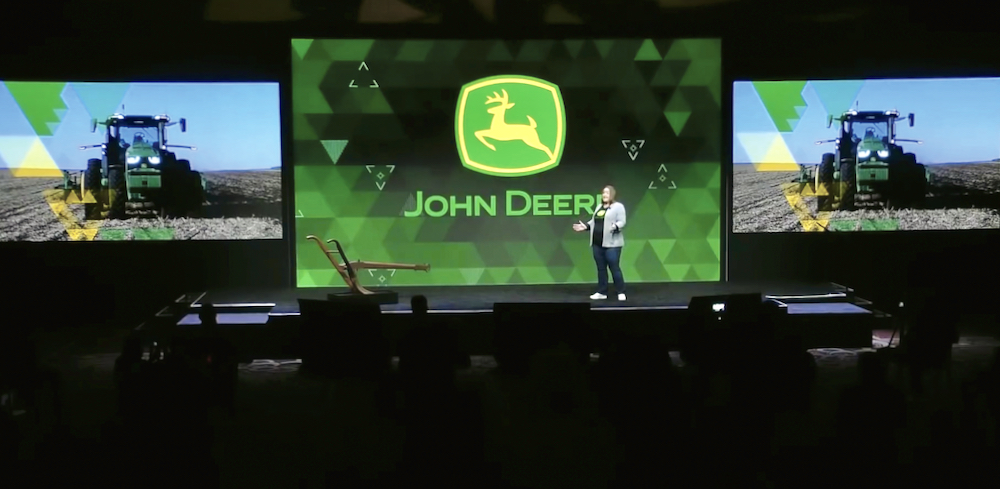
Once a farmer drives the 8R to a field, it can be let loose to work on its own, unsupervised.
“When the tractor is running autonomously, farmers can monitor its progress remotely on a smartphone, tablet or computer,” said Kovar. “They could be watching from inside the cab of another John Deere piece of equipment in a nearby field, from their office or somewhere else entirely. Not only are they tracking where the tractor is, they’re tracking the quality of job it’s doing and if any adjustments need to be made.”
“The farmer only needs to transport the tractor to the field and configure it for autonomous operation,” added Julian Sanchez, Deere’s director, emerging technology. “Pull out their phone, swipe it from left to right and the machine starts. With a quick beep the machine signals all clear — if it is all clear — and starts working. At that point the farmer is now free to leave it.
“The farmer is going to want to check on it. They can do that through the John Deere Operations Centre app. And they can do that at any point. They’ll have access to live video images, data and metrics on how the machine is doing. And they can adjust things like speed remotely.
“If there are any job quality anomalies or machine issues, the farmer will be notified remotely and can make a judgment to optimize performance. Anything out of the ordinary that occurs when the tractor is active, the farmer will be notified and be able to make decisions remotely through the John Deere Operations Centre.”
How it works
The autonomous tractor looks at its surroundings through six pairs of stereo cameras, which give it 360-degree obstacle detection and allow it to determine its distance from objects. Images captured by the cameras are passed through a deep neural network that classifies each pixel in approximately 100 milliseconds and determines if the machine continues to move or stops, depending on if an obstacle is detected. The autonomous tractor is also continuously checking its position relative to a geofence, ensuring it’s operating where it is supposed to, and is within less than an inch of accuracy.
“Robots need to do two things — perceive their environment and make good decisions about what they perceive,” said Willy Pell, senior director of autonomous systems.
“The tractor has redundant safety systems to make sure core components are functioning properly. Depending on the obstacle, whether it’s a tree branch or animal, the machine either continues or it stops. Achieving high degrees of safety and productivity have been the core challenges of this project. “One of the things that makes autonomy in agriculture really challenging is rare, difficult to foresee, events for which we have no training data. For example, a billboard falls in a field. The tractor needs to be able to stop. However, for something that obscure, we’re not going to have adequate training data. To handle these types of situations, we built an anomaly detection system, which recognizes nominal images of sky, ground and trees. When it encounters new objects that don’t fit within the standard class of objects, the machine just stops. Using this technology, we’re able to achieve a very high degree of safety and performance, despite situations where the tractor sees a completely new or random object.”
First releases of the autonomous 8R are expected later this year.
Said Hindman, ending the press conference, “Autonomy is no longer just a concept or a demo. It’s real. It’s ready. And it’s helping farmers today.”




